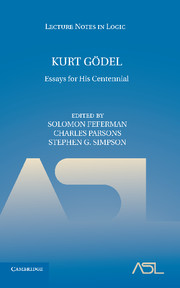Gödel and set theory
Published online by Cambridge University Press: 04 August 2010
Summary
Kurt Gödel (1906–1978) with his work on the constructible universe L established the relative consistency of the Axiom of Choice (AC) and the Continuum Hypothesis (CH). More broadly, he ensured the ascendancy of first-order logic as the framework and a matter of method for set theory and secured the cumulative hierarchy view of the universe of sets. Gödel thereby transformed set theory and launched it with structured subject matter and specific methods of proof. In later years Gödel worked on a variety of settheoretic constructions and speculated about how problems might be settled with new axioms. We here chronicle this development from the point of view of the evolution of set theory as a field of mathematics. Much has been written, of course, about Gödel's work in set theory, from textbook expositions to the introductory notes to his collected papers. The present account presents an integrated view of the historical and mathematical development as supported by his recently published lectures and correspondence. Beyond the surface of things we delve deeper into the mathematics. What emerges are the roots and anticipations in work of Russell and Hilbert, and most prominently the sustained motif of truth as formalizable in the “next higher system”. We especially work at bringing out how transforming Gödel's work was for set theory. It is difficult now to see what conceptual and technical distance Gödel had to cover and how dramatic his re-orientation of set theory was.
- Type
- Chapter
- Information
- Kurt GödelEssays for his Centennial, pp. 145 - 180Publisher: Cambridge University PressPrint publication year: 2010



